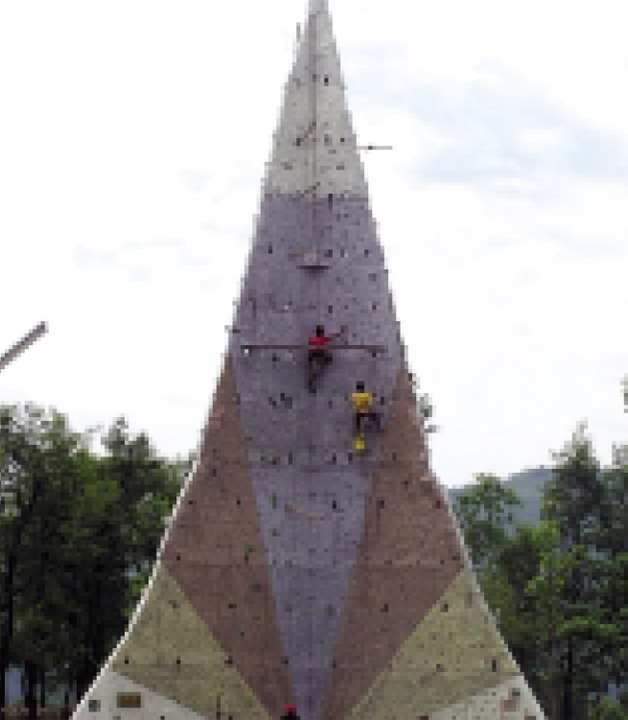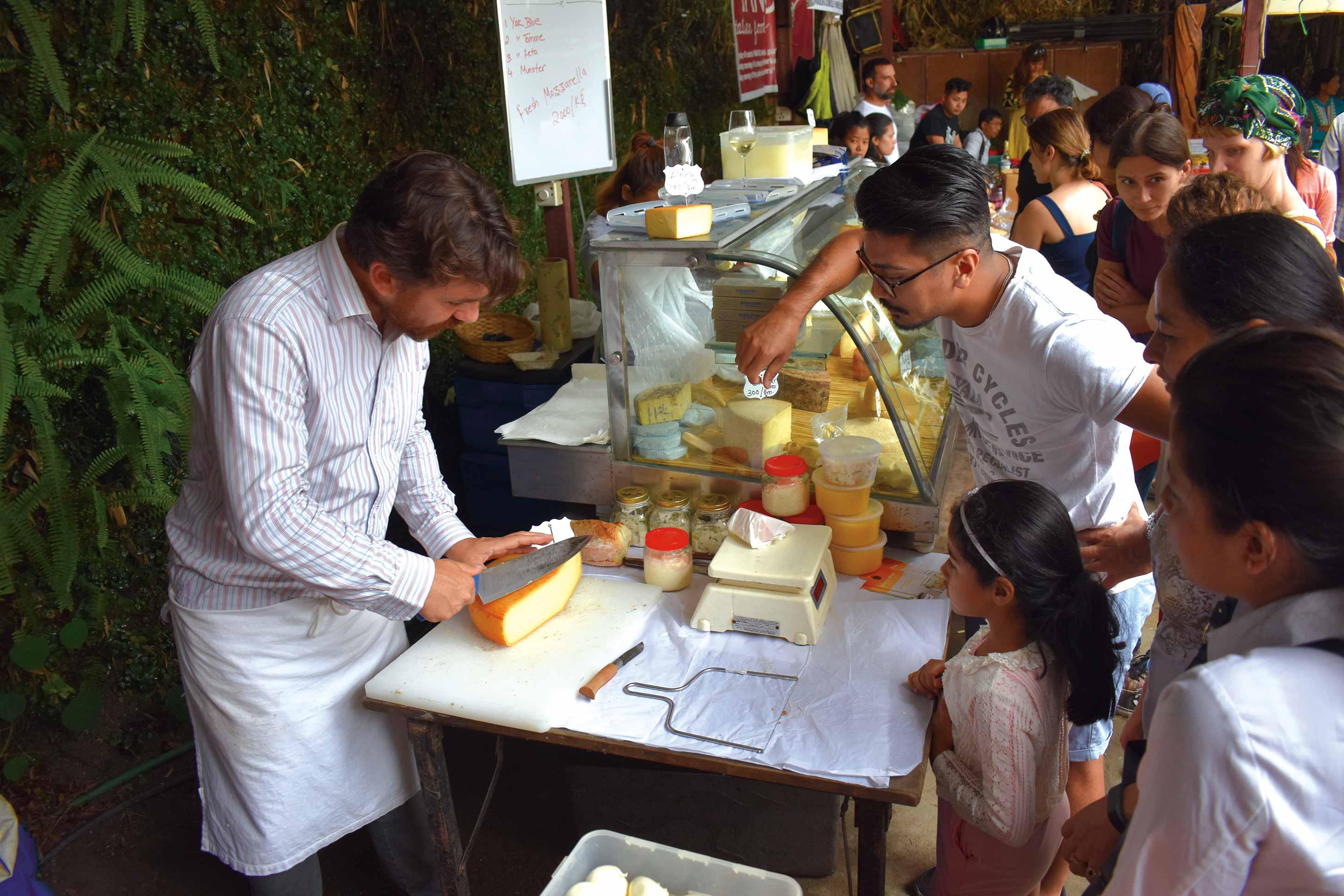Climbing walls are ideal tools for novice climbers to learn the skill in a safe environment before graduating to seemingly more dangerous rock/mountain climbing. Besides being a recreational activity, wall climbing when done after properly warming up the body is good for toning and building muscle strength.
 I thought I knew all there was to know about walls. They function as a barrier to outsiders around one’s property. Even the Great Wall of China, visible all the way from the moon, was built for this specific purpose. But along comes “wall climbing”, a relatively new sport in Nepal where you have a wall made for the sole purpose of recreational climbing.
I thought I knew all there was to know about walls. They function as a barrier to outsiders around one’s property. Even the Great Wall of China, visible all the way from the moon, was built for this specific purpose. But along comes “wall climbing”, a relatively new sport in Nepal where you have a wall made for the sole purpose of recreational climbing.
Usually in mountain and rock climbing, climbers more often than not have to drive bolts into the rock face at sections devoid of natural cracks that serve as handholds and toe grips. It soon occurred to climbers that placing bolts all the way up to the top made climbing easier for the less experienced climbers. A natural progression of that idea led to wall climbing. Climbing walls are concrete/synthetic walls designed to replicate natural rock or mountain surfaces. Hand holds and toe grips are placed at intervals on the wall. Walls can be made more difficult or less difficult to climb by the strategic location and number of hand holds and toe grips. Climbing walls are ideal tools for novice climbers to learn the skill in a safe environment before graduating to seemingly more dangerous rock/mountain climbing
Pasang Lhamu Climbing Center in Dhumbarahi, Chakrapath is one of the places in Kathmandu that has a climbing wall. “The ten meter wall is a prodigious challenge for first-timers but many have conquered it with regular training and practice,” says Mr. Hari Krishna Thapa, office secretary of Pasang Lhamu Climbing Center. Fridays, Saturdays and Sundays are their busiest days. Climbing gear which includes safety belt, climbing shoes and chalk bags can be rented at the center.
The center offers two climbing courses—the basic course and the advanced course. The basic course is a seven day course that orients climbers to the climbing equipments, knot tying, belay techniques, climbing styles and rappelling. The fees for Nepalis are NRs 3599/- for adults and NRs 2099/- for children. The fees for non-Nepalis are NRs 4799/- for adults and NRs 2799/- for children. At the end of the seven-day basic course, climbers are given an opportunity to scale a natural rock face in Nagarjun. The advanced course is a two-week course that delves into advanced climbing techniques, solo and leads climbing with a focus on communication and leadership skills. Fees for Nepalis for the advanced course are NRs 5555/- for adults and NRs 2999/- for children. The feels for non-Nepalis are NRs 6999/- for adults and NRs 3999/- for children. Climbers below the age of 16 must submit waivers and have a parent or a guardian to supervise their climb.
The center is also venue to climbing competitions with professional judges for the event. The wall can also be rented for the day by schools, colleges and professional/community groups for recreational activities or competitions. Orientation and supervision will be provided by the staff. In addition to the courses and group renting, the center also offers a membership package on daily, weekly, monthly, half yearly and annual basis.
If you are keen but still have reservations about taking it up, fret not. Climbing has been made easy by qualified trainers who are there to guide and coach climbers through the modus operandi. Besides being a recreational activity, wall climbing when done after properly warming up the body is very good for toning and building muscle strength. It also increases self confidence, flexibility, concentration and self control. The level of adrenaline rush grows the higher one climbs. What’s more, it can also be a good way to overcome one’s fear of heights.
Adventure sport is now commonplace in today’s pop culture. Adrenaline junkies have never had it better. We’re participating in activities that our bodies were never designed for. We were never meant to fall hundreds of meters off the sky and land on the ground safely. We were never meant to be 8850 meters above mean sea level on top of Mt. Everest. We were never meant to travel at speeds faster than our average human running speed (approximately 30kmph) let alone achieve super sonic speeds. We were never meant to go into the depths of the oceans or explore the vast expanses of outer space. There are things that we humans were never meant to be doing. But the need to challenge boundaries is what makes us the dominant species of our planet. Whilst wall climbing may not measure up to such extremes, it is as close as we everyday people may get. Climbing walls are a small tribute to that human ambition in all of us. And if there is a wall in our way, then by god we shall climb it!
For details: Pasang Lhamu Mountaineering Foundation. Ph:4370742
e-mail: plmf@info.com.np
Climbing wall, Kakani
With financial assistance from the Embassy of the French Republic, a climbing wall was built at the International Mountaineers’ Memorial Park in Kakani. A French volunteer, Henry Sigaret, played a vital role in the construction stage. The climbing wall was then officially handed over to Nepal Mountaineering Association (NMA) by His Excellency Michel Jolivet, the Ambassador of the French Republic on 28th January 2006 at Kakani. The wall now open to the public is 12 m in height covering an area of 96 sq. m.
Climbing Wall in Pokhara
His Excellency Michel Jolivet, Ambassador of French Republic also inaugurated the Artificial Climbing wall that has been built in the premises of the International Mountain Museum, Pokhara on 22nd May 2006. The wall was built with a fund of NRs 7,00,000/- received from the Embassy of the French Republic. The wall which is 21m 40 cm in height, covering an area of 196 sq m, has been opened to the public.
For details: NMA 4434525
Email: office@nepalmountaineering.org










